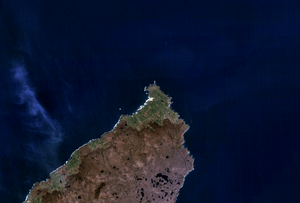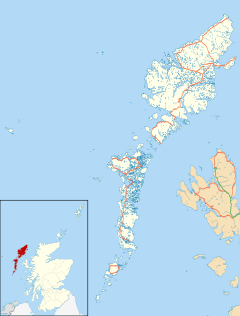Ness, Lewis facts for kids
Quick facts for kids Ness
|
|
|---|---|
 Landsat image of the north of Lewis |
|
| Population | 1,300 |
| Language | Scottish Gaelic English |
| OS grid reference | NB5261 |
| Civil parish | |
| Council area | |
| Lieutenancy area | |
| Country | Scotland |
| Sovereign state | United Kingdom |
| Post town | STORNOWAY |
| Postcode district | HS2 |
| Dialling code | 01851 810 |
| Police | Northern |
| Fire | Highlands and Islands |
| Ambulance | Scottish |
| EU Parliament | Scotland |
| UK Parliament |
|
| Scottish Parliament |
|
Ness (Nis in Scottish Gaelic) is the very northern tip of the Isle of Lewis in Scotland. It is a community made up of about 16 small villages. Some of these villages include Lionel, Habost, Cross, and Port of Ness. The name "Ness" comes from an old Norse word meaning "headland." Many other place names in the area also have Norse origins.
Ness was once the most north-westerly community in the European Union. Its most northern point is a place called the Butt of Lewis.
Ness is part of the Galson Estate. This land is owned by a group called Urras Oighreachd Ghabhsainn (Galson Estate Trust). It is managed by 10 local people chosen by the community. They took over ownership on January 12, 2007.
You can reach Ness by driving on the A857 road. It is about 40 kilometres (25 miles) by road from Stornoway. You can also walk to Ness from North Tolsta in Back. This walk is about 16 kilometres (10 miles) long and takes around 6 hours.
Most people in Ness speak Scottish Gaelic. About 75% of the community can speak it. People in Ness used to cut peat from the moor. They used it as fuel for cooking and heating their homes. However, using peat is becoming less common now. In 2001, the population of Ness was just under 1,000 people. Back in 1831, there were over 3,000 people living in Ness.
Contents
Important Places in Ness
Ness has some interesting landmarks. One is the 13th-century Teampull Mholuaidh. This old church is located in Eoropie.
Dùn Èistean: An Ancient Island Home
Another important place is the small island of Dùn Èistean. This island is the historic home of the Lewis Morrisons. They are part of the Clan Morrison. There is a road sign pointing to a bridge that crosses to Dùn Èistean. Archaeologists have been doing digs there to learn more about its past. Morrisons from Harris and Lewis traditionally lived around Ness. They also lived in the north-west Highlands, near the town of Durness.
The Guga Hunt Tradition
Every year, 10 men from Ness go to the island of Sula Sgeir. They go in late August for two weeks. Their goal is to harvest about 2,000 young gannets. These birds are known locally as Guga. The Guga hunt is a long-standing tradition in Ness. The bird is considered a special food.
A Local Hero: John F. Macleod
Ness is also known for a brave boat builder named John F. Macleod. He was from Port of Ness. He saved 40 lives when the ship H.M.Y. Iolaire sank. He managed to get a rope to the shore, helping people escape.
The Sgoth Fishing Boat
Ness is famous for its Sgoth. This is a special type of wooden boat. It has a unique sail called a dipping lug sail. These boats were used for line fishing until the early 1900s. Several Sgoth boats are still used today. Local community groups take care of them.
Education in Ness
Lionel School is the main school for children in Ness. The school is proud of its sports achievements. Students have won many awards for football, running, badminton, and swimming. The school currently has 116 students.
A smaller school in Cross closed in 2011. It closed because fewer students were attending, with only 19 pupils at the end. The buildings are now used by Comunn Eachdraidh Nis. This is the Ness Historical Society.
Sports and Activities
Football is the most popular sport in Ness. The local team, Ness FC, plays its home games at Fivepenny Machair.
Spors Nis: Community Sports Centre
"Spors Nis" is a modern sports centre that opened in 2007. It has many great facilities. These include a two-lane 10 pin bowling alley. Lionel School also has a swimming pool. The public can use the pool when the school is not using it.


